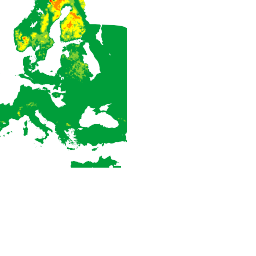ユニバーサル花粉指数(UPI)とは
ユニバーサル花粉指数(UPI)は、異なる地域の花粉飛散量を比較するための世界共通の指標として設計されています。この指数は、花粉症や花粉に敏感な人がさまざまな要因に基づいて花粉にさらされるリスクを評価するのに役立ちます。多層モデルに基づいており、植物ごとの濃度モデル、世界中で使用されているさまざまな地域の花粉指数(LPI)、さまざまな植物の花粉タイプの抗原性を考慮した花粉レベルのデータ表現であり、1 日あたりの花粉の数(個/m3)を予測します。
heatmapTiles エンドポイントは、ベースマップに重ね合わせることができるヒートマップ タイルを返します。ヒートマップ タイルには、特定の植物タイプ(TREE、GRASS、WEED)の UPI が世界中で表示されます。
この指数は次の 6 つのカテゴリで構成されています。
| 値 | 色 | 説明 |
|---|---|---|
| 0 | なし | |
| 1 | 非常に少ない | |
| 2 | 低 | |
| 3 | 中 | |
| 4 | 高 | |
| 5 | 非常に高い |
各カテゴリは、特定の地域における花粉の濃度レベルと、通常経験するアレルギー症状の重症度への影響に基づいており、花粉レベルを包括的に表しています。UPI を統合することで、ユーザーはさまざまな場所の花粉の状況を比較して評価できます。
たとえば、次のヒートマップ タイルは、TREE の花粉レベルが「非常に少ない」から「非常に多い」までの範囲であることを示しています。

対応植物
Pollen API は、草、雑草、木の 3 種類の植物をサポートしています。植物のデータは実際のデータソースの測定値とレポートに基づいており、Pollen API の植物データは地域によって異なる場合があります。
次のリストに、サポートされているプラントコードとそのメタデータを示します。
| プラント コード | 表示名 | タイプ |
|---|---|---|
ALDER |
Alder | ツリー |
ASH |
アッシュ | ツリー |
BIRCH |
シラカバ | ツリー |
COTTONWOOD |
Cottonwood | ツリー |
ELM |
Elm | ツリー |
MAPLE |
Maple | ツリー |
OLIVE |
オリーブ | ツリー |
JUNIPER |
Juniper | ツリー |
OAK |
オーク | ツリー |
PINE |
Pine | ツリー |
CYPRESS_PINE |
ヒノキ、マツ | ツリー |
HAZEL |
Hazel | ツリー |
GRAMINALES |
イネ科の植物 | 草 |
JAPANESE_CEDAR |
日本の杉 | ツリー |
JAPANESE_CYPRESS |
ヒノキ | ツリー |
RAGWEED |
ブタクサ | 雑草 |
MUGWORT |
ヨモギ | 雑草 |

